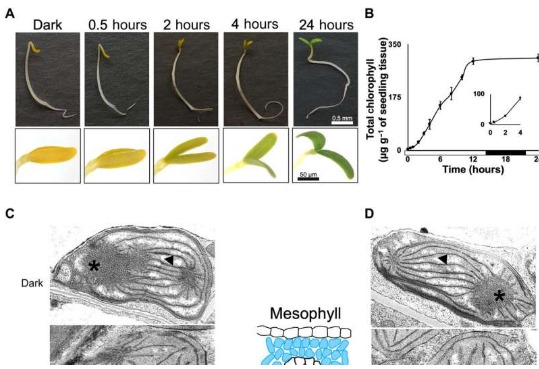
Response of cotyledons to light in G. gynandra. (A) Representative images of G. gynandra seedlings illustrating greening and unhooking of the cotyledons. (B) Total chlorophyll over time (data shown as means from three biological replicates at each time point, ± 1 SD from the mean). First 4 hours shown in inset. Bar along the x axis indicates periods of light (0 to 14 and 22 to 24 hours) or dark (14 to 22 hours). (C and D) Representative transmission electron micrographs of etioplast to chloroplast transition in mesophyll (C) and bundle sheath cells (D) at 0, 0.5, 2, 4, and 24 hours after exposure to light. Asterisks and arrowheads indicate the prolamellar body and prothylakoid membranes, respectively. Scale bars represent 0.5 mm for seedlings (A) and 50 μm for cotyledons (A) and 500 nm (C and D).
New research in the field of plant sciences has made significant advances towards understanding the underlying reasons behind why certain crops are better at generating more yield than others.
The study, published in the journal Science Advances, paves the way for how smart plants could be engineered in the future to improve their productivity and yield.
The research—conducted at the Department of Plant Sciences, University of Cambridge, and led by Dr. Pallavi Singh, currently at the University of Essex's School of Life Sciences—focused on photosynthesis, which is one of the most complicated and important processes that plants use to turn light, carbon dioxide, and water into sugars that fuel life on Earth.
There are two kinds of photosynthesis: C3 and C4. Most food crops—such as rice, wheat, barley and oats—depend on the less efficient C3 photosynthesis, where carbon is fixed into sugar inside cells called 'mesophyll' where oxygen is abundant. However, oxygen can hamper photosynthesis. C4 crops—such as maize, sugarcane, sorghum and millets—have evolved specialized 'bundle sheath' cells to concentrate carbon dioxide, which makes C4 photosynthesis as much as 60 percent more efficient, particularly in hot and dry environments.
Due to the global rise in temperatures, C3 plants are growing in regions which are often hot and dry, meaning they could benefit from the energy-saving mechanisms of C4 photosynthesis. However, C4 photosynthesis is very complex, poorly understood, and has only been investigated mainly on a gene-by-gene basis to see if its mechanism can be used to improve productivity of C3 crops.
Click here to see more...